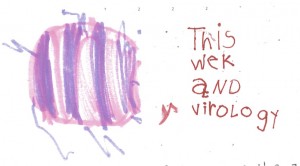 Hosts: Vincent Racaniello, Rich Condit, Alan Dove, and Kathy Spindler
Hosts: Vincent Racaniello, Rich Condit, Alan Dove, and Kathy Spindler
Vincent, Rich, Alan and Kathy review aerosol transmission studies of influenza H1N1 x H5N1 reassortants, H7N9 infections in China, and the MERS coronavirus.
Click arrow to play
Download TWiV 233 (71 MB .mp3, 98 min)
Subscribe (free): iTunes, RSS, email
Links for this episode:
- Aerosol transmission of H1N1 x H5N1 reassortants (Science)
- It’s good science (virology blog)
- Viral engineering dangers (Nature)
- Colorblind web page filter
- Influenza H7N9 update (ProMedMail)
- Influenza H7N9 risk assessment (WHO, pdf)
- Influenza H7N9 confirmed cases (WHO)
- New coronavirus gets a new name (ScienceInsider)
- Novel coronavirus infection update (WHO)
- Coronavirus infections (WHO)
- Letters read on TWiV 233
Weekly Science Picks
Alan – Space Oddity (YouTube)
Rich – Walk through giant colon
Vincent – Transport proteins
Kathy – Vomiting Larry (YouTube)
Listener Pick of the Week
Tom – US patent system is broken (DailyTech)
Send your virology questions and comments (email or mp3 file) to [email protected]


TWiV233
13:30 Chen paper
all 127 are infectious,
17:20 started in 2010
1830 mice first , gets into CNS
19:00 virulence in mice correlates with virulence in humans
20:00: intranasally into mice
45 similar pathologic. as H5N1
38 less
34 more virulent
24:00 polymerase responsible for virulence in mice
25:00 guinea pigs cheaper than ferrets, breathing is enough
to transmit
27:00 chart because paper so complicated
28:00 some transmit efficiently
E627K not needed
(not all H5 are much similar) Kawaoke in ferrets
31:00 not predictor but mechanistically
none lethal in guinea pigs but lethal in mice
34:00 1918 nasty in mice+people, some correlation mice-humans
35:00 R: less correlation for lab-viruses
37:00 May nasty
—- Wain Hobson—-:
R:, not predictive
D:not 80% predictive, but
ferret different than Guinea
R: 100K-100M deaths –> irresponsible
D: better we know it if dangerous
{do it, but don’t publish critial info }
{international agreements needed}
42:00
44:00 K: too scary
C: made within 2 years, doubts it
not so dangerous , interesting
ongoing discussion (NIH)
46:00 R: too scary
colors
49:00 H7N9
53:00 closing down markets is the reason for the stop of cases
54:00 weather plays a role ?
57:00 2 WHO documents recommended
57:30 MERS
…
127 combinations may be an impressive effort, but I am finding difficulty counting to say “all the 127 combinations”. To replace some segments of 8 segments RNA genome of H1N1 with those from H5N1, you have 256 combinations (you take segment #1 from either H1N1 or from H5N1, segment #2 from either one, …) and two of these combinations are pure H1N1 and H5N1 (i.e. not reassortant), so wouldn’t the all combinations be 254? Why are the other 127 combinations immaterial?
They kept H5 constant in all of the reassortants, so it’s 2^7 rather than 2^8. 2^7=128 but if you don’t count the original virus it’s 127.
BTW doing this by coinfection would be possible but horrendous. You’d get all the viruses mixed together and you’d have to plaque them out and screen individual plaques to pick out the specific reassortants you wanted. Using “reverse genetics” (sorry Vincent) is much more efficient.
Co-infection using multi-plex qPCR can be done easier than people think…in fact I argue that compared to all the time needed for cloning with reverse genetics that its about the same amount of time. What co-infection tells you is the ‘trends” in reassortment, meaning the likely-hood for gene compatibility. If you screen 800 plaques how many are or a particular gene constellation? This is very informative. Would a certain gene constellation dominate (more plaques) over both the pH1N1 and H5N1 strain in a cell line of choice (pigs, human, etc.)? You don’t necessarily get that with reverse genetics, although the replication data via reverse genetics hints at the likelihood. Both reverse genetics and co-infection are powerful. I’ve screened 800 plaques for all 8 genes after co-infection. Cataloging the whole process takes about 3 months…not the funnest thing but that’s what Ph.D. students are for 🙂
http://www.cidrap.umn.edu/cidrap/content/influenza/panflu/news/mar2913ethics.html
> Hale said the group has talked with close to 200 scientists, most of them virologists,
> about the issue since February 2012. “A large majority of them share all of these concerns,
> excluding the influenza people,”
so either the influenza people are biased, or they have better insight which they failed to
communicate to the other virologists
> The FVR wants to see an independent risk assessment of gain-of-function research, Hale said.
> “It really is astonishing that 12 to 15 months into this debate we still don’t have an independent
> risk assessment.”
(IMO) that risk assessment must involve reassortment statistics, a review of all the flu-reassortment
studies and comparison with natural,pandemic reassortments.
It must -almost by definition- include probability estimates of occurring natural
pandemic strains and manmade pandemic strains.
It must estimate the chances to either understand how these pandemic reassortment
strains are found by nature or to just efficiently approximate this by more and more
“brute force” experiments, how to find the critical reassortments and adaptions.
I’d love to see that !